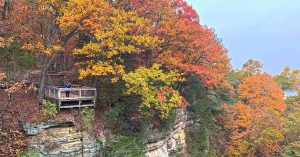A fall trip to Starved Rock State Park is close to home but a world apart
Chronicle Media — October 5, 2023
Take a hike through Starved Rock State Park along the Illinois River and witness fall’s splendor.
Starved Rock State Park, located along the Illinois River in LaSalle County, is one of the state’s most beautiful destinations and is especially lovely in the fall.
Better yet, it’s close to home via a short drive on Illinois Route 71 through Kendall County or less than a hour south/southwest of DeKalb.
And best of all? It’s free.
Perhaps the best way to catch seasonal colors is to hike any of the 13 miles of trails, split into 16 designated paths ranging from just over one-half mile round trip to four miles from start to finish.
The trails allow access to rain fed waterfalls, sandstone overhangs and spectacular overlooks. Lush vegetation such as white and red oak, maple, hickory, white pine, eastern red and northern white cedar support abundant wildlife.
Along with informal walks, there are also frequent trolley rides and river cruises available throughout October, including spooky ghost tours.
Special events this month include a Falltober Fest at the Lodge on Oct. 21, including hikes and fun for kids and adults.
Visitors can even spend a night or two inside the park. The1930s stone and log Starved Rock Lodge and Conference Center offers accommodations although available dates in October are already limited. Nearby camping is also available and reservations are required.
Hiking, however, is forbidden after dark and never on unmarked trails at any time. Don’t climb the cliffs, swim or wade and keep pets on leashes. Bicycling on hiking trails is prohibited. And don’t remove or destroy plants or animals, including wildflowers.
Violating park rules can result in eviction and/or arrest.
Starved Rock was designated as Illinois’ second state park in 1911. The park’s 18 canyons feature vertical walls of moss-covered sandstone formed by glacial meltwater that slice dramatically through tree-covered sandstone bluffs.
This area has been home to humans as early as 8000 B.C. Hopewellian, Woodland and Mississippian Native American cultures thrived in the region. The most recent and probably the most numerous group of Native Americans to live in the region were the Illinois.
Various subtribes who belonged to the Illinois Confederation occupied the area from the 16th through the early 19th centuries. The Kaskaskia people were one of those subtribes. They lived directly across from present day Starved Rock State Park in an area known as the Grand Village or La Vantum by the French.
In 1673, French explorers Louis Jolliet and Jesuit missionary, Father Jacques Marquette, passed through the area on their way up the Illinois from the Mississippi River. Known as “Pere,” the French word for “Father,” Marquette returned two years later and founded the Mission of the Immaculate Conception, Illinois’ first Christian mission, at the Kaskaskia village.
The French built Fort St. Louis atop Starved Rock in the winter of 1682-83 because of its commanding strategic position above the Illinois River. Pressured from small war parties of Iroquois in the French and Indian wars, the French abandoned the fort by the early 1700s and retreated to what is now Peoria, where they established Fort Pimitoui. Fort St. Louis became a haven for traders and trappers, but by 1720 all remains of the fort had disappeared.
Starved Rock State Park derives its name from a Native American legend of injustice and retribution. Chief Pontiac of the Ottawa tribe was slain by a Peoria brave (the Peoria were a sub-tribe of the Illinois Confederation) while attending a tribal council in southern Illinois.
According to the legend, during one of the battles that subsequently occurred to avenge his killing, a band of Illinois, under attack by a band of Potawatomi (allies of the Ottawa), sought refuge atop a 125-foot sandstone butte (today’s Starved Rock). The Ottawa and Potawatomi surrounded the butte and held their ground until the hapless Illinois died of starvation—giving rise to the name Starved Rock.
The park is open daily from 7 a.m. to sunset and any trip should start by picking up a map at the Visitor Center, open daily (except for state and federal holidays) from 9 a.m.-4 p.m.
Call the park office at 815-667-4726 or visit www.starvedrocklodge.com/starved-rock-state-park/



